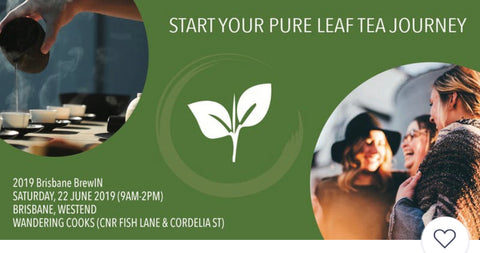PURE LEAF TEA 101
This is a quick wrap up of the 2019 Brisbane BrewIN workshop 'Pure Leaf Tea 101'
According to Chinese legend, tea was accidentally discovered in 2737 BC by Chinese emperor & herbalist Shennong when a few leaves from an ancient tea tree fell into his bowl of boiling water. Shennong researched the leaves and discovered the medicinal properties of the tea leaves. From then on for centuries, tea was used as a medicine & eaten as a vegetable before it became popular as a beverage in the 6th century.
In this workshop we covered the history of tea, learnt about the five different tea varieties, brewing tips and sampled five artisan loose leaf tea varieties.
All tea types (Black, Green, Oolong, Pu-erh & White), come from the leaves and buds of one very special plant called Camellia Sinensis. The tea plant ranges from small shrubs to large ancient tea trees.
A particular tea type is determined by how the tea leaves are harvested and processed. Listed below is a brief description of the five main tea types along with names and steeping guides of all the teas that we sampled at the workshop:
WHITE TEA
White tea gets its name from the tiny, silver hairs on the dried leaves. This tea is carefully harvested by hand once a year, for only a few weeks in early spring. White tea is made with young buds and leaves that are carefully picked and dried. This tea is the least processed and closest you can get to the natural state of tea leaf.
White tea sampled at the workshop:
ORIGIN: Mt. Taimu, Fujian Province, China
STEEPING GUIDE: Tea: 2 g Water: 85 C, 1 cup Time: 5-8 minutes
RE-STEEP: 3 times
FLAVOR PROFILE: Lightly floral and fruity fragrance, mellow & brisk taste with lingering sweetness
GREEN TEA
Green tea is made using young tea leaves that are picked, wilted and then either pan fired or steamed to stop the oxidization of the leaves. There are numerous varieties of green tea with unique flavours. Usually Chinese green teas are toasty, nutty & floral & Japanese teas are vegetal with marine notes, rich in umami.
Green tea sampled at the workshop:
TEA: Chun Ya
ORIGIN: Mt. Tiangong, Sichuan Province, China
STEEPING GUIDE: Tea: 3 g Water: 85 C, 1 cup Time: 3-5 minutes
RE-STEEP: 3-4 times
FLAVOR PROFILE: Fragrant, sweet and mellow
OOLONG TEA
Oolong tea is a complex tea that has a variety of leaf and crafting style, creating a broad range of flavors and aroma. It is a semi-oxidized tea, falling in between a black and a green tea. The natural oils of the tea leaves are released by shaking the leaves and the leaves are left to partially oxidise. Oxidisation levels range between 10% - 80% and therefore Oolongs have a wide variety of flavors ranging from floral, butter, nuts, burnt sugar and chocolate.
Oolong tea sampled at the workshop:
TEA: Jin Xuan
ORIGIN: Alishan, Nantou, Taiwan
STEEPING GUIDE: Tea: 3 g Water: 95 C, 1 cup Time: 3-5 minutes
RE-STEEP: 3-4 times
FLAVOR PROFILE: Highly aromatic with distinct floral & creamy notes
BLACK TEA
Black tea is a fully oxidized tea. It undergoes withering, rolling of the leaves to release all the natural oils, the leaves are left to fully oxidise and then it is fired to dry. Black tea can have a wide range of flavors depending on where it is grown. Indian black teas are usually robust, full bodied and malty, whereas the Chinese black teas tend to be sweet, floral and sometimes smoky.
Black tea sampled at the workshop:
ORIGIN: Tong Mu Guan, Wuyi mountain, China
STEEPING GUIDE: Tea: 3 g Water: 90 C, 1 cup Time: 3-5 minutes
RE-STEEP: 3-4 times
FLAVOR PROFILE: Pine wood smoky aroma, smooth taste with sweet & mellow aftertaste
PU-ERH TEA
Pu-erh tea dates back to 1700’s & is one of the oldest types of Chinese teas. It was used as a bartering currency between China & Tibet.
Pu-erh tea is a unique fermented tea which is grown and harvested in the city of Pu’er (China). Pu-erh is made from special broad tea leaves that have a rare chemical composition that make them suitable for ageing. Just like fine wine, this tea naturally develops and improves with age. This tea is renowned for its unique flavor and health benefits.
Pu-erh tea sampled at the workshop:
TEA: Pu-erh Cube Mini Tuocha (2006)
ORIGIN: Pu’er city, Yunnan Province, China
STEEPING GUIDE: Tea: 1 piece Water: 100 C, 1 cup Time: 5-8 minutes
RE-STEEP: 4-5 times
FLAVOR PROFILE: Rich & mellow earthy taste with smooth & sweet aftertaste

